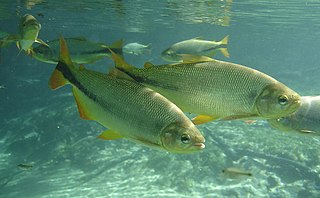
Ancistrus is a genus of nocturnal freshwater fish in the family Loricariidae of order Siluriformes, native to freshwater habitats in South America and Panama. Fish of this genus are common in the aquarium trade where they are known as bushynose or bristlenose catfish. In the aquarium hobby they are often referred to as bushynose or bristlenose plecos instead, but this may lead to confusion as "pleco" usually is used for Hypostomus plecostomus and its allies and is often used as a catchall term for any loricariids remotely resembling that species.

Hyphessobrycon is a genus of freshwater fish in the family Characidae. These species are among the fishes known as tetras. The genus is distributed in the Neotropical realm from southern Mexico to Río de la Plata in Argentina. Many of these species are native to South America; about six species are from Central America and a single species, H. compressus is from southern Mexico.

Astyanax is a genus of freshwater fish in the family Characidae of the order Characiformes. Some of these fish, like many of their relatives, are kept as aquarium pets and known collectively as tetras. With around 150 described species and new ones being described yearly, this genus is among the largest of the entire order; Hyphessobrycon also has more than 145 species and which one is larger at any one time depends on whether more species have been recently described in one or the other. The blind and colorless cave tetra of Mexico is a famous member of the genus, but its taxonomic position is disputed: Some recognize it as part of the Mexican tetra and this is supported by phylogenetic evidence, but others recognize the cave form as a separate species, A. jordani.

The Doradidae are a family of catfishes also known as thorny catfishes, raphael catfishes or talking catfishes. These fish are native to South America, primarily the Amazon basin and the Guianas.

Rineloricaria is a genus of freshwater tropical catfish belonging to the family Loricariidae. They are commonly called whiptail catfish because of the long filament that grows out of the tip of the caudal fin that is characteristic of the genus. With the exception of R. altipinnis from Panama, they are native to the rivers of northern and central South America. Some species are regularly seen in the aquarium trade.

Steindachneridion is a genus of South American pimelodid catfish.

Pimelodus is a genus of fish in the family Pimelodidae native to Central and South America.
Harttia is a genus of armored catfishes native to South America.

Parotocinclus is a genus of fish in the family Loricariidae native to South America. This genus is distributed through almost all hydrographic systems in South America from the Guyana Shield drainages and Amazon Shield tributaries to the coastal drainages of eastern and southeastern Brazil, including the rio São Francisco basin. Most species have the caudal peduncle oval in cross section. It has been found that Characidium species may interact with P. maculicauda. The small Characidium will follow grazing P. maculicauda, which release particulate matter dislodged from the catfish's foraging.

Alburnus is a genus of fish in the family Cyprinidae, the carps and minnows. They are known commonly as bleaks. A group of species in the genus is known as shemayas. The genus occurs in the western Palearctic realm, and the center of diversity is in Turkey.

Brycon is a genus of fish in the family Characidae found in freshwater habitats in Central and South America, ranging from southern Mexico to northern Argentina. Despite not being closely related to true trout, they are sometimes called South American trout. Members of the genus may be referred to by a number of other different common names in various languages. They reach a maximum length of 11.9–79.5 cm (4.7–31.3 in) depending on the species involved. Some species perform seasonal breeding migrations.

Pimelodella is a genus of three-barbeled catfishes.

Moenkhausia is a genus of freshwater fish in the family Characidae native to tropical and subtropical South America. These are medium-sized tetras where the largest species only reach around 12 cm (4.7 in).

Characidium is a genus of fish in the family Crenuchidae. They are mainly found in South America, but C. marshi is from Panama. They are small, slender fish that live on the bottom in flowing fresh waters and feed on small animals such as insects.

Austrolebias is a genus of killifish in the family Rivulidae. These annual killifish live in temporary pools, swamps and streams in the Río de la Plata, Patos–Mirim and Mamoré basins in South America.
Paenibacillus tylopili is a soil-dwelling, Gram-positive, rod-shaped bacterium. Described as new to science in 2008, it was found in the mycorhizosphere of the bolete fungus Tylopilus felleus.
Parotocinclus cristatus is a species of catfish in the family Loricariidae. It is native to South America, where it is known from coastal rivers near Ilhéus in the state of Bahia in Brazil. The species reaches 4 centimeters (1.6 in) in total length.
Parotocinclus haroldoi is a species of catfish in the family Loricariidae. It is native to South America, where it is known from the state of Piauí in Brazil, with a 2020 redescription defining its range as the Parnaíba River basin. The species reaches 3.5 cm SL.
Parotocinclus cabessadecuia is a species of catfish in the family Loricariidae. It is a freshwater species native to South America, where it occurs in the Parnaíba River basin of Brazil, alongside its congeners Parotocinclus haroldoi and Parotocinclus cearensis. The species reaches at least 3.32 cm SL. It was described in 2017 by T. P. Ramos, S. M. Lima, and R. T. Ramos. FishBase does not list this species.















